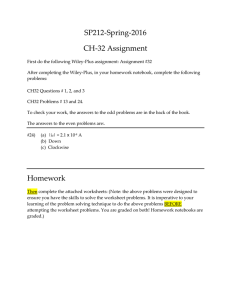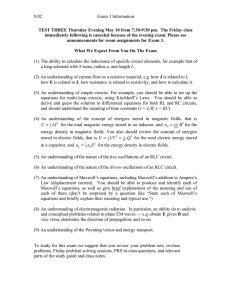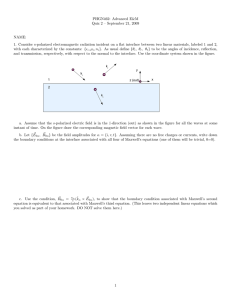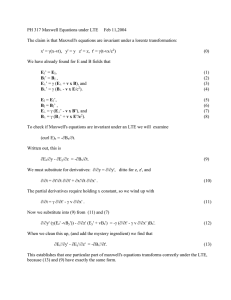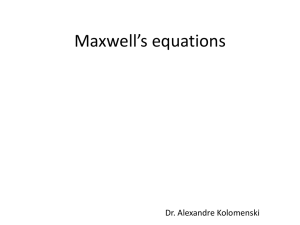RES.TLL-004 STEM Concept Videos, Fall 2013 Transcript – Maxwell’s Equations
advertisement
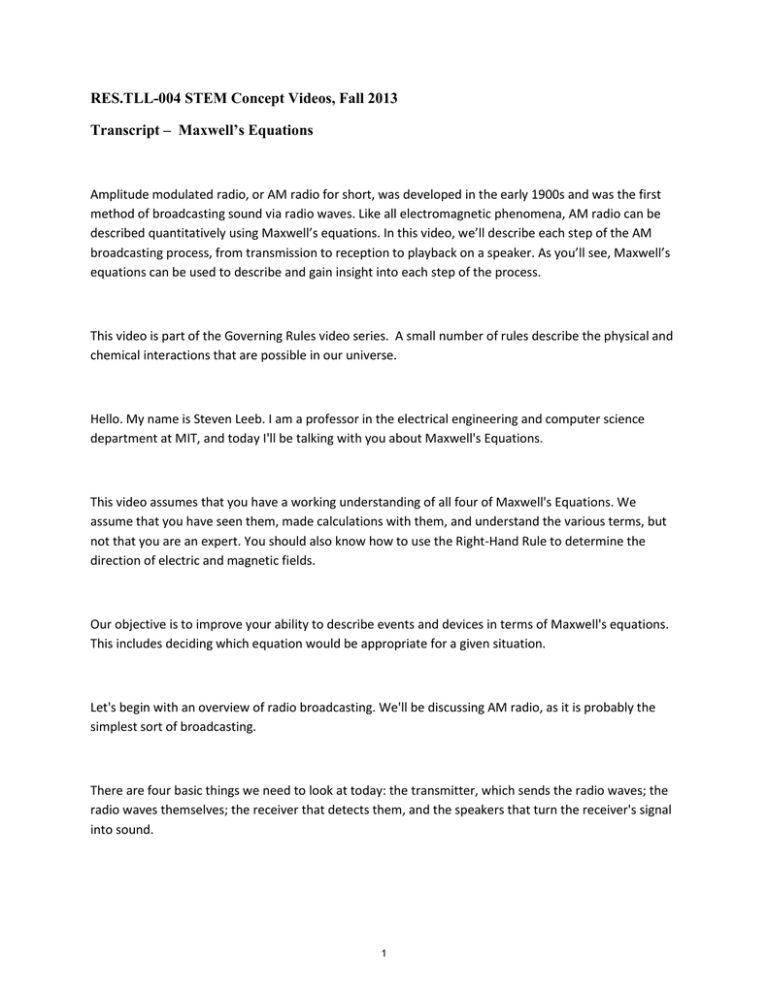
RES.TLL-004 STEM Concept Videos, Fall 2013 Transcript – Maxwell’s Equations Amplitude modulated radio, or AM radio for short, was developed in the early 1900s and was the first method of broadcasting sound via radio waves. Like all electromagnetic phenomena, AM radio can be described quantitatively using Maxwell’s equations. In this video, we’ll describe each step of the AM broadcasting process, from transmission to reception to playback on a speaker. As you’ll see, Maxwell’s equations can be used to describe and gain insight into each step of the process. This video is part of the Governing Rules video series. A small number of rules describe the physical and chemical interactions that are possible in our universe. Hello. My name is Steven Leeb. I am a professor in the electrical engineering and computer science department at MIT, and today I'll be talking with you about Maxwell's Equations. This video assumes that you have a working understanding of all four of Maxwell's Equations. We assume that you have seen them, made calculations with them, and understand the various terms, but not that you are an expert. You should also know how to use the Right-Hand Rule to determine the direction of electric and magnetic fields. Our objective is to improve your ability to describe events and devices in terms of Maxwell's equations. This includes deciding which equation would be appropriate for a given situation. Let's begin with an overview of radio broadcasting. We'll be discussing AM radio, as it is probably the simplest sort of broadcasting. There are four basic things we need to look at today: the transmitter, which sends the radio waves; the radio waves themselves; the receiver that detects them, and the speakers that turn the receiver's signal into sound. 1 This picture shows an overview of the process. The transmitting tower, on the left, produces radio waves that travel through the air until a receiver detects them and sends a signal to a speaker. The tower is typically about one hundred meters tall, and the receiver is about ten centimeters wide. The transmitter is a tall metal tower with alternating current attached to it at high voltage. In AM radio, the whole tower is electrified. The entire thing acts as the antenna, which is not true for all types of broadcasting, such as for FM radio or cell towers. This next diagram shows the radio waves as they move outward from the transmitter. Specifically, it shows the electric part of the electromagnetic waves. You can see their shape drawn in orange, and their magnitude shown in black below that. Next we have the receiver. The receiver is a set of wire coils. These detect the radio wave and transmit a signal to a stereo system so that you can hear the sound. Our final piece is the speakers, which turn electrical impulses into sound that you can hear. Now it's your turn. With a partner, try to describe where each of Maxwell's Equations comes into play in this situation. It may help you to break the situation down, draw diagrams, write the laws down, consider the terms in the equations, and perhaps even redraw the pictures. Pause the video here to discuss and consider the possibilities. Now that you've had time to think, it's time for a discussion. Your professor will lead the class through sharing the ideas and diagrams you came up with. At this stage we will not be deciding whether any ideas are right or not - the idea is just to get everyone's ideas out in the open. Pause the video here for the discussion. 2 Now that you've had time to share some of your ideas, let's get an expert look at where Maxwell's Equations apply to broadcasting. Make sure to note whether or not you thought of each of these situations as we describe them. You may be missing some, or you may have even come up with a few more. We will return to your brainstorms in a minute. Let's examine the transmitting tower first. The AC generator will drive positive charges to one end of the tower, and negative charges to the other. Using Gauss' Law, we can surround each of these with a Gaussian surface. Our electric field lines will point outward from the positive charges, and inward toward the negative charges. In addition, because this is an AC power source, our positive and negative charges will constantly be shifting from one end of the tower to the other. After many cycles of this, we will end up with an electric field radiating outward from the tower. That field changes direction every half-cycle. Let's look at the tower again in a different way. If we consider the current rather than the charges, we know that it will be moving up and down the tower. To analyze the magnetic field the current creates, we can use Ampere's Law, and draw an Amperian loop around the tower. The Right-Hand Rule will give us the direction of the magnetic field from this current, which will change as the current changes direction. As with the electric field, this magnetic field will oscillate and change direction with time. While we look at this view, we can also work in another one of Maxwell's Equations, sometimes called Gauss' Law for Magnetism or the Statement of No Magnetic Monopoles. You can see that, like all magnetic field lines, the magnetic field lines created by our tower have no start point or end point. They wrap around the tower and connect with themselves. 3 Let's move on to the radio waves. As they move, the electric field at each point in space changes. That leads us to the Ampere-Maxwell Law, which handles changes in electric flux. The law states that a change in electric flux will induce a magnetic field. We can draw that in on our picture. When we look at the magnetic field, it also changes in time. Faraday's Law handles changing magnetic flux, and tells us that it induces an electric field. Again, the two fields are perpendicular. When our electric field reaches the antenna, we would be tempted to use the Ampere-Maxwell Law again. We know that there is a change in the electric field, which would induce a magnetic field... but magnetic fields are not easy to detect. This method is not very useful. Instead, AM antennas rely on Faraday's Law. Faraday's Law states that changes in the magnetic flux will induce an electric field. As the electromagnetic wave passes through the antenna, the electric field in the loop will generate a current, which is easy to detect! We can plug this antenna into our stereo and hear the sound that comes out. Now it's time to look at the speaker. Here is some video from my laboratory at MIT. In general, we have two categories to consider. A charge or a current can create a field, and we use Gauss' Law or Ampere's Law to investigate. If we have oscillating fields, we switch to Faraday's Law or Ampere's law with Maxwell's extension. We also can't forget the Lorentz Force Law. While it's not one of Maxwell's equations, it's still very important to the study of electromagnetism. Now it's time to return to your brainstorms. Your professor will lead the class in a discussion and examination of the brainstorms you presented before. Remember that there are many different ways in which Maxwell's Equations can describe electromagnetic phenomena. Just because something on your list was not on our list does not mean that you were wrong. I hope you appreciated our discussion of radio today. Good luck in your further studies of Maxwell's Equations. 4 MIT OpenCourseWare http://ocw.mit.edu RES.TLL.004 STEM Concept Videos Fall 2013 For information about citing these materials or our Terms of Use, visit: http://ocw.mit.edu/terms.
